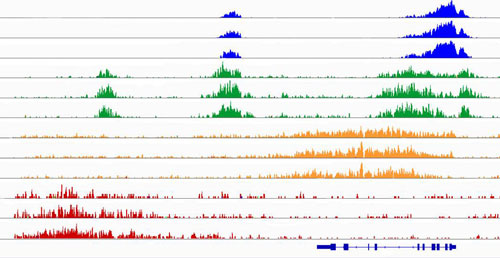| Jun 02, 2014 |
How the environment and genetics impact our DNA
|
|
(Nanowerk News) The impact of the environment on our genetic makeup has long been a topic of discussion among researchers. Now a European consortium (EURATRANS) headed by Professor Norbert Hübner of the Max Delbrück Center for Molecular Medicine (MDC) Berlin-Buch has taken the opposite approach. The scientists have investigated for the first time to what extent specific genetic predispositions influence the processes of gene regulation. Thus, they attempt to elucidate why certain environmental factors have different effects, e.g. why salt causes blood pressure to rise sharply in some people and not in others. With their study they are pursuing a new approach to investigating these phenomena by linking different genetic analysis methods with each other ("Natural variation of histone modification and its impact on gene expression in the rat genome").
|
|
Humans have hundreds of different kinds of cells such as blood, kidney, liver or heart cells. All cells – except for the red blood cells – have a cell nucleus, in which the DNA with its approximately 20, 000 genes is packaged. Although the cells all have the same genetic makeup, in the different cell types different genes are active or inactive. How the genes are regulated has long been intensively researched.
|
 |
| Why do certain environmental influences have different effects? Modifications in the histones, the proteins around which DNA is wrapped, are one explanation for this. Depending on how loosely or tightly the DNA is packed around the histones, the genes can either be read out or not. The graphic shows different histone modifications of a randomly selected region of the genome of three laboratory rats with an activated gene and a non-activated region (red). (Graphic: Christin Mieth/MDC)
|
|
“Epigenetics - link between genes and the environment”
|
|
In this context, a new concept in genetics emerged a few years ago: epigenetics. “Epigenetic factors are the link between genes and the environment,” said Dr. Carola Rintisch (MDC), explaining this phenomenon. Together with Dr. Matthias Heinig (MDC and the Max Planck Institute for Molecular Genetics, Berlin) she is the lead author of the study. Epigenetic factors regulate the activity of genes, without changing the sequence of the gene constituents. “Therefore, the next logical step was to examine the extent to which the genes can influence epigenetic factors,” Dr. Rintisch added.
|
|
The focus of the study was on histone modifications, which are among the epigenetic factors. The DNA coils around the histone proteins and, depending on how loosely or how tightly the DNA is packed around the histones, the genes can either be read out or not. The packing condition is controlled by enzymes that bind small molecules (methyl groups) to specific loci in the histones. The histone modifications caused by the different histone methylation are critical for the gene regulation. However, the role of histones and their packing conditions are still poorly understood.
|
|
Aim – to identify susceptibility for diseases
|
|
To study the impact of genetic variability on histone marks, the researchers compared the genomes of two strains of rats – one with normal blood pressure – the other with cardiovascular diseases and metabolic disorders – with the annotated histone modification maps. Already here they could determine differences in histone modification of the two strains. To determine the genetic factors that trigger the histone modifications, another 30 strains of rats were studied, all of which emerged from the two parent strains and respectively have a “genetic mosaic” of the two rat strains.
|
|
Dr. Wei Chen of the Berlin Institute for Medical Systems Biology (BIMSB) of the MDC then sequenced the processed samples from heart and liver tissues of the animals (ChIP-sequencing). In particular in the heart tissue, the researchers identified several gene regions (QTL – Quantitative Trait Loci) that affect histone modification and thus gene activity.
|
|
“Our publicly accessible records could help to identify genetic variations that suggest a susceptibility to cardiovascular and metabolic diseases," explained Professor Hübner. "At the same time we have shown with our approach a novel way to discover new links between genetic makeup (genotype) and the environment (phenotype)."
|

